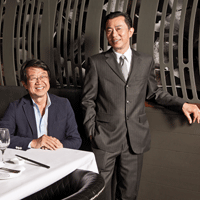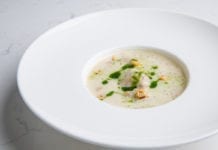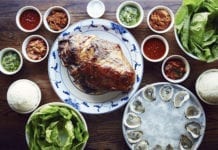In this new economy, where restaurants operate within smaller footprints, with less staff and a higher turnover of tables per night, the Toronto-based Spoon and Fork is taking a different approach. At the budding all-you-can-eat concept, bigger is better, and there are no signs development is slowing.
Inside the chain’s 6,000-square-foot, 170-seat restaurant in Etobicoke, Ont., the atmosphere is frenetic. Servers in black uniforms rush to and fro picking up plates of Japanese and Thai dishes from an open-concept kitchen. The well-dressed clientele linger over afternoon business meetings or dinner dates. The energy is contagious, filling every nook and cranny, from the packed booths to the busy bar to the line of customers who may wait an hour to be seated.
The owners of the Japanese/Thai concept take cultural cuisine to another level, offering a multi-ethnic, all-you-can-eat model in an upscale environment. Diners choose from unlimited or à la carte Japanese dishes such as fried wonton, fresh mango salad and spicy tuna maki, or Thai dishes such as curry pumpkin soup, sweet-and-sour fish and smoked duck curry. Each item is plated in a simple, individual-sized portion, ideal for sharing. To wash it down, the staff serves Sapporo from the tap or premium Sake martinis, such as the Saketini made with sake, vodka or gin, with a twist of lemon ($8). Guests can choose from 10 brands of Sake, which range in price from $4.95 for 180mL of Gekkeikan Premium House Sake, to $43 for 300mL of Wakatake Ginjo Onikoroshi Sake. The menu also offers 36 wines from Canada, France, Australia and Chile.
Although the concept is sprouting up in all corners of the Greater Toronto Area (GTA), the brand hasn’t always been so fruitful. It originally opened as a Thai and Vietnamese concept in 2003 in Etobicoke, but when Hong Kong-born Matthew Lam and Sunny Chong, decided to replace Vietnamese with Japanese, their business blossomed. By 2012, the family of restaurants had grown to include three Spoon and Fork Japanese/Thai locations units in Woodbridge, Etobicoke and Oakville; this fall the owners will open one more Spoon and Fork in West Oakville. Overall, the duo, who have been friends and business partners for more than 10 years, oversee five Spoon and Fork operations (two Thai/Vietnamese, three Japanese/Thai), plus, two other concepts called Prince Japanese Steakhouse and JJ Japanese Thai, also located in the GTA.
The secret to their success is exceeding customer expectations. “If you go into any one of my restaurants … you’ll get a wow feeling, and that sets the tone of the dining experience,” explains Lam, referring to the restaurant design by Toronto’s Symbolics Architecture and Design firm. In fact, the Etobicoke location was featured at the IIDEX Canada “Dine by Design” hospitality show last September. Here’s why: a grand entryway greets guests, introducing the restaurant’s intricate design that’s augmented by long panels of glass and hollow wooden lights from Italy. A grand painting depicting a Buddhist figure covers one wall, while a large booth in the back sits underneath a chandelier made of spoons, forks and knives.
The setting is opulent, but the mandate is to offer a fine-dining experience without pretense or exorbitant expense. “We try to define our customer,” Lam explains, alluding to the $27.99 unlimited menu, à la carte pricing and the restaurant’s policy of charging diners for unfinished items. “If I start with a lower price, then [I] attract the wrong crowd.” The crowd typically includes couples, businesspeople and tourists, who share their experience with friends and family. And word-of-mouth is the PR machine, since little is spent on advertising.
Other restaurateurs are seemingly taking notice, too. Lam says combining Japanese and Thai has inspired a chain reaction in the city. “When we put the Japanese and Thai together tons of people started opening [similar concepts]. And then we started all-you-can-taste, and people started doing all-you-can-eat. But they don’t do the same thing we do,” Lam boasts, explaining that his restaurants stand out from other Asian concepts because of the unique design and decor.
What differentiates Spoon and Fork is its owners’ commitment to serve quality, good-tasting food, but that’s only part of the recipe to success. “Obviously the food has to taste good. To me, that’s Restaurant 101. We spend money on the ambiance, and hopefully our wait staff does a good job. Then, you put the three together and that becomes a dining experience. That’s our goal,” Lam says. “[There’s] lots of room for improvement but that’s what we are trying to do.”
Growth is on the agenda, but the owners are hesitant to jump into new markets without studying the trends and demographics. “We always check the market, check what kind of food is more sellable and what kind of food is not, and sometimes we add a new dish and change some dishes, too. It just keeps on changing,” adds Chong.
The fluid nature of the business is evident in each of the individual designs and menus. It’s about constantly surprising guests by adding elements of the surrounding community to each site, such as incorporating Roman-style columns into the design of its Woodbridge location to reflect the Italian heritage of its community. As the owners anticipate the upcoming Oakville opening in early October, they are experimenting with adding new dishes such as pasta to the menu. Surprising, yes, but it’s another detail that creates a wow experience.
Keep Reading
Start me Up: Uncovering What’s Big in Small Plates
A Close Look At Rapid-Cook Technology
Reduce Customer Traffic Declines This Winter





















